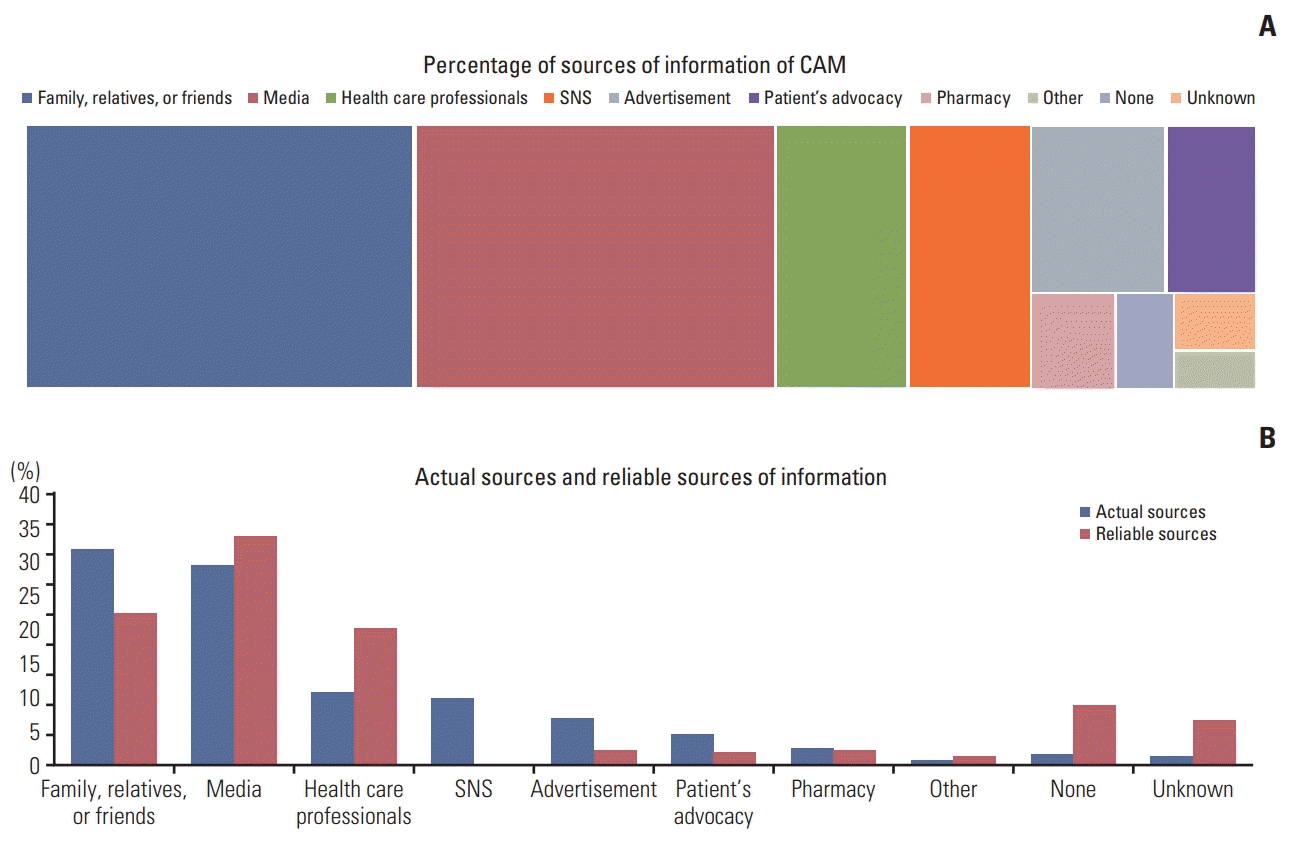1. Torre LA, Bray F, Siegel RL, Ferlay J, Lortet-Tieulent J, Jemal A. Global cancer statistics, 2012. CA Cancer J Clin. 2015; 65:87–108.

2. Jung KW, Won YJ, Kong HJ, Lee ES; Community of Population-Based Regional Cancer Registies. Cancer statistics in Korea: incidence, mortality, survival, and prevalence in 2015. Cancer Res Treat. 2018; 50:303–16.

3. Rashrash M, Schommer JC, Brown LM. Prevalence and predictors of herbal medicine use among adults in the United States. J Patient Exp. 2017; 4:108–13.

4. Buckner CA, Lafrenie RM, Denommee JA, Caswell JM, Want DA. Complementary and alternative medicine use in patients before and after a cancer diagnosis. Curr Oncol. 2018; 25:e275–81.

5. Berretta M, Della Pepa C, Tralongo P, Fulvi A, Martellotta F, Lleshi A, et al. Use of complementary and alternative medicine (CAM) in cancer patients: an Italian multicenter survey. Oncotarget. 2017; 8:24401–14.

6. Choi JY, Chang YJ, Hong YS, Heo DS, Kim S, Lee JL, et al. Complementary and alternative medicine use among cancer patients at the end of life: Korean national study. Asian Pac J Cancer Prev. 2012; 13:1419–24.

7. Scott JA, Kearney N, Hummerston S, Molassiotis A. Use of complementary and alternative medicine in patients with cancer: a UK survey. Eur J Oncol Nurs. 2005; 9:131–7.

8. Hlubocky FJ, Ratain MJ, Wen M, Daugherty CK. Complementary and alternative medicine among advanced cancer patients enrolled on phase I trials: a study of prognosis, quality of life, and preferences for decision making. J Clin Oncol. 2007; 25:548–54.

9. John GM, Hershman DL, Falci L, Shi Z, Tsai WY, Greenlee H. Complementary and alternative medicine use among US cancer survivors. J Cancer Surviv. 2016; 10:850–64.

10. Tascilar M, de Jong FA, Verweij J, Mathijssen RH. Complementary and alternative medicine during cancer treatment: beyond innocence. Oncologist. 2006; 11:732–41.

12. National Center for Complementary and Integrative Health. The use of complementary and alternative medicine in the United States [Internet]. Bethesda, MD: National Center for Complementary and Integrative Health;c2008. [cited 2018 Dec 16]. Available from:
https://nccih.nih.gov/research/statistics/2007/camsurvey_fs1.htm.
13. Meijerman I, Beijnen JH, Schellens JH. Herb-drug interactions in oncology: focus on mechanisms of induction. Oncologist. 2006; 11:742–52.

14. Mohd Mujar NM, Dahlui M, Emran NA, Abdul Hadi I, Wai YY, Arulanantham S, et al. Complementary and alternative medicine (CAM) use and delays in presentation and diagnosis of breast cancer patients in public hospitals in Malaysia. PLoS One. 2017; 12:e0176394.

15. Nahin RL, Barnes PM, Stussman BJ. Expenditures on complementary health approaches: United States, 2012. Natl Health Stat Report. 2016; (95):1–11.
16. Bauml JM, Chokshi S, Schapira MM, Im EO, Li SQ, Langer CJ, et al. Do attitudes and beliefs regarding complementary and alternative medicine impact its use among patients with cancer? A cross-sectional survey. Cancer. 2015; 121:2431–8.

17. Barrett B, Marchand L, Scheder J, Plane MB, Maberry R, Appelbaum D, et al. Themes of holism, empowerment, access, and legitimacy define complementary, alternative, and integrative medicine in relation to conventional biomedicine. J Altern Complement Med. 2003; 9:937–47.

18. Institute of Medicine, Committee on the Use of Complementary and Alternative Medicine by the American Public. Complementary and alternative medicine in the United States. Washington, DC: National Academies Press;2005.
19. Eardley S, Bishop FL, Prescott P, Cardini F, Brinkhaus B, Santos-Rey K, et al. CAM use in Europe: the patients’ perspective. Part I: a systematic literature review of CAM prevalence in the EU. Southampton: University of Southampton;2012.
20. Alostad AH, Steinke DT, Schafheutle EI. International comparison of five herbal medicine registration systems to inform regulation development: United Kingdom, Germany, United States of America, United Arab Emirates and Kingdom of Bahrain. Pharmaceut Med. 2018; 32:39–49.
21. Job KM, Kiang TK, Constance JE, Sherwin CM, Enioutina EY. Herbal medicines: challenges in the modern world. Part 4. Canada and United States. Expert Rev Clin Pharmacol. 2016; 9:1597–609.

22. Mehta DH, Gardiner PM, Phillips RS, McCarthy EP. Herbal and dietary supplement disclosure to health care providers by individuals with chronic conditions. J Altern Complement Med. 2008; 14:1263–9.

23. Tarn DM, Karlamangla A, Coulter ID, Paterniti DA, Knox L, Khang PS, et al. A cross-sectional study of provider and patient characteristics associated with outpatient disclosures of dietary supplement use. Patient Educ Couns. 2015; 98:830–6.

24. Kennedy J, Wang CC, Wu CH. Patient disclosure about herb and supplement use among adults in the US. Evid Based Complement Alternat Med. 2008; 5:451–6.

25. Farooqui M, Hassali MA, Abdul Shatar AK, Shafie AA, Farooqui MA, Saleem F, et al. Complementary and alternative medicines (CAM) disclosure to the health care providers: a qualitative insight from Malaysian cancer patients. Complement Ther Clin Pract. 2012; 18:252–6.

26. Ernst E. The role of complementary and alternative medicine. BMJ. 2000; 321:1133–5.

27. Corbin Winslow L, Shapiro H. Physicians want education about complementary and alternative medicine to enhance communication with their patients. Arch Intern Med. 2002; 162:1176–81.

28. Evans M, Shaw A, Thompson EA, Falk S, Turton P, Thompson T, et al. Decisions to use complementary and alternative medicine (CAM) by male cancer patients: information-seeking roles and types of evidence used. BMC Complement Altern Med. 2007; 7:25.

29. Latte-Naor S, Sidlow R, Sun L, Li QS, Mao JJ. Influence of family on expected benefits of complementary and alternative medicine (CAM) in cancer patients. Support Care Cancer. 2018; 26:2063–9.







 PDF
PDF Citation
Citation Print
Print




 XML Download
XML Download